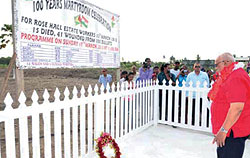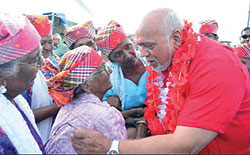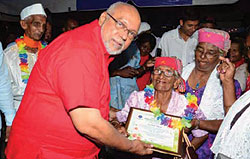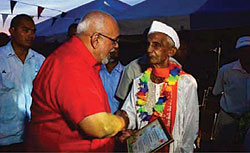|
It was the famous scientist Albert Einstein who confidently posited, “we owe a lot to the Indians, who taught us how to count, without which no worthwhile scientific discovery could have been made!" Indeed, not only the world at large owes Indians for their scientific contributions, but also for their efforts made in the fight for equalities and human rights. Their struggles can never be repaid; however, the most honorable gesture is to recognize and continue the never ending battle for a space where rights are not trampled upon. Our ancestors taught the world that safeguarding the rights of others is the most noble and beautiful end of a human being.
At a memorial service held on Monday, 25th March, 2013 at the Old Burial Ground in Rose Hall, East Canje, I tried to hold back my tears to no success, upon learning of the price my ancestors paid for justice. It was the first time a memorial ceremony was held for fallen workers, who were killed on the 13th March, over 100 years ago. Among those paying tribute to the dead were President Donald Ramotar, representatives of the Guyana Agricultural and General Workers Union (GAWU), Golden OM Dharmic Youth Organization, the Regional Chairman, as well as Dr. Fred Sukdeo, whose close relatives were among those shot and killed.
I viewed the procession that marched from the “High Bridge” -the spot where the workers were killed- and ended at the burial ground. Having listened to the tributes paid I convinced myself that this marked a dark centenary in Guyanese history; a date that should never be forgotten.
 |
 |
| President Ramotar pays floral tribute to Rose Hall Martyrs |
President Ramotar meeting elderly residents |
President Donald Ramotar said that the workers “made that ultimate sacrifice” and despite it being 100 years later, he urged all to remember them. He recognized this incident as the push factor for the scrapping of the “hated system of indentureship”. He further noted that from the time indentureship replaced slavery, the workers played the most central role in transforming Guyana. The bulk of the struggle, he stated, was in the sugar estate in 1948 at Enmore. “This was the beginning of the end of colonialism in our country—all those struggles took place in the estates themselves and….we will always have to pay tribute to sugar workers and the role that they play”, he explained. “Sugar was then ‘king’—the main pillar of the economy”.
I immediately said to myself I needed to venture on a thorough history check as I was completely unaware of the details of these incidents. The history treat by the Head of State propelled me to venture into a time machine, via
Google.
My travel began with my first search using the key words, “1913 Rose Hall Killings”. I am happy to share this piece I composed having read the works of a number of authors who penned these remarkable historical pieces.
The Journey- 100 Years Back In Time
The 1912 crop season was successful at Plantation Rose Hall in Berbice. It was a norm for a few days of holidays o be granted at the end of the grinding season. The workers’ performances were exceptional as some even worked on Sundays. The Estate Manager, Mr. James Smith having met Mr. Hunter, the Assistant Manager, promised four days of holidays, effective from 28th January, 1913.
On 27th January 1913, holidays were granted by Mr. Smith. He urged them to utilize the time for maintenance and cleaning of their living quarters. This order, initially, caused some dissatisfaction. On the 28th January, 1913, their dissatisfaction increased when the holidays granted were cancelled by Mr. Smith, citing there was planting to be done. He told them that later in the year, they would reclaim these days. Workers, as expected refused to conform and prevented their colleagues from returning to work on that day.
 |
 |
| President Ramotar makes presentation to oldest female Rose Hall resident |
President Ramotar makes presentation to oldest male Rose Hall resident |
The indentured laborers/workers reported for duty on the 29th January, 1913, but by weekend Mr. Smith summoned legal action against the seven “ring leaders” for their perceived role in perpetuating the strike. This move agitated the other workers. Smith refused the request of dropping the charges. The group of workers then walked to New Amsterdam and highlighted their plight to the Immigration Agent, Mr Fairbairn. The Agent was able to influence Smith to rescind his decision but wanted the workers to compensate him for the legal advice. The workers requested that the payments be made “little by little” as they earned.
At the court hearing, (during mid February 1913) about 300 indentured laborers/workers vociferously disputed the charges and threatened retaliation if their colleagues were charged. The men appeared before Magistrate Shankland at the New Amsterdam court. The defense counsel, Joseph Eleazer, advised the seven men to plead guilty and the magistrate fined them three shillings (72 cents) each and ordered them to keep the peace for six months. Mr. Smith was not pleased with this ruling. He requested the Immigration Agent General to transfer Jangi Khan (ringleader) and his family along with four other indentured labourers; Amir Baksh, Chotey Khan, Maula Bux, and Mathura to other estates, labeling them as the protest instigators.
The tension continued to grow leading to an uproar from the 4th March onwards, as some workers were charged for poor work quality. In the days after, those who refused to work tussled with the police, when they transported others who chose to work. On one occasion, the workers heard rumors that the police had entered their rooms to molest their wives. They openly called for the dismissal of the deputy manager and the deceptive driver,
Jagmohun.
They workers continued to protest against the transfer of the five men. During the protest, they prevented others from entering the estate including the drivers and overseers. As matters intensified, uncontrollable behavior developed, which resulted in damages to the estate property. At the time, twenty-five additional armed constables were posted to Rose Hall at the request of Mr. Hunter (who now assumed the role of Manager since Mr. Smith was ill and away in England).
The grim day of 13th March, 1913 saw workers attending the court hearings instead of working. On the same day, the Inspector General of Police of the then British Police Force, George Castriot De Rinzy (1865-1913) and the Immigration Director from Georgetown, unexpectedly agreed to transfer the five “ring-leaders” since police motorcars were present. Maula Bux, the Muslim newcomer to the colony and to agricultural labor was the first target. He showed them a soiled copy of the immigration ordinance that he had collected in India. Maula Bux, being knowledgeable about the province knew that the indentured immigrant workers worked more hours than were legal, without being paid the legal minimum. He insisted that management lacked legal grounds for a transfer. “They know I can read and suspect me of teaching the people not to go to their work, and so they (falsely) put this blame on me,” he said. In front of the colony’s immigration chief, Bux vowed, “Over my dead body can you remove us from this plantation”.
Jangi Khan, another target sought by the police, was prevented from entering the vehicle. The authorities responding to the strength of the crowd, decided to put the transfers on hold, besides the men “old ring- leaders” needed time to gather their possessions.
The police force ledby De Rinzy and Police Inspector James Ramsay went to Rose Hall, on the same day, to maintain order and to arrest five “new ring leaders” who were blamed for inciting violence. They were Ganga, Dildar Khan, Shankar, Bholay and Ramdyal. Having seen the police, the crowd assumed that the policemen were about to have these “new ring leader's transferred as had happened with the previous” ring leaders”. They were not aware that the police were granted warrants to arrest these men because they threatened violence. This caused the rioting crowd to erupt.
The police, armed with rifles appealed to the threatening crowd to disperse, and subsequently, read the Riot Act. They then arrested Ganga, and were immediately attacked by the crowd. The policemen brutally and indiscriminately fired their weapons at the large gathering of indentured and free workers who were armed only with bottles and sticks.
There was a hand- to- hand physical struggle between Motey Khan and Corporal James Ramsay which resulted in both of them falling into the punt trench and later succumbing to gun shots. Today, it is not certain of the bullets’ origin nor whether the shot fired at the Corporal’s head was deliberate or not. Colonel De Rinzy, in a testimony said the death of the corporal fuelled him to open fire, which resulted in the shooting of 57 persons with 100 bullets.
As a result of this confrontation, fifteen workers—14 men and one woman—were killed. The dead were: Badri, 26; Bholay, 33; Durga, 72; Gafur, 27; Jugai, 30; Juggoo, 37; Hulas, 25; Lalji, 45; Motey Khan, 26; Nibur, 75; Roopan, 25; Sadulla, 23; Sarjoo, 21; Sohan, 33; and the lone female Gobindei, 32.
Their bodies were transported in jute bags on donkey carts to the New Amsterdam Hospital. Forty-one workers were injured. The slain workers were buried in mass graves in Canefield Settement, East Canje (opposite the Community Centre). The circumstances of the killings were investigated by an appointed Commissioner. He found that there was a lapse in communication between the police and the workers. They did not inform the workers of their intentions. Despite this finding, no blame was placed on the police for the killings.
The Daily Argosy’s headline which screamed bloodshed was seen by two special envoys who were visiting at that time from India. Six months after, the Viceroy’s Legislative Council in Delhi concluded that workers received “considerable provocation and had good reason to complain of unfair treatment”. While their call for compensation for the surviving relatives and victims was futile, their involvement did convince the government of India to abolish the Indentureship Scheme in 1917.
Upon reflecting on the 1913 Rose Hall Rebellion, sentiments of pride and emotion are evoked on considering the courage and zest displayed by the brave men and women, we call our ancestors. Indeed, this remains to date, perhaps, one of those powerful revolts which left a mark on our work force.
—This article has been reproduced with permission from Horizons Magazine,
Guyana.
|